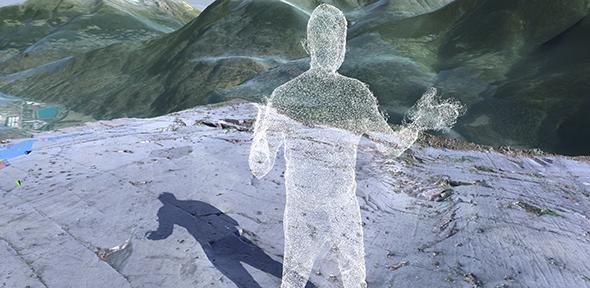
Dr Frederick Baker and Marcel Karnapke have been awarded the 3D Media Guild award in virtual reality animation for their film 'Pitoti Prometheus'.
The 17 minute long 360° virtual reality (VR) film uses the 3D scans of prehistoric rock art from Valcamonica and the performances of volumetrically scanned actors, to dramatise an episode from the classical Greek tale of Prometheus using dialogue from the German poet Goethe.
The film is a Digital Humanites research project and creates a 360 degree spherical image around the user. It focuses on the moment when Prometheus raises humankind from the rocks and so brings static figures to life. This moment of animation echoes the work of the European Union funded 3D Pitoti research consortium, who worked on the 3D scanning, analysis and visualisation of the Camunian rock art between 2013 and 2016.
The film was developed by the McDonald Institute for Archaeological Research and was a Cambridge University deliverable. Through the EU FP7 consortium, Baker and Karnapke worked closely with the Bauhaus University in Weimar in Germany, using new volumetric camera techniques developed by Stefan Beck at the Virtual Reality Lab, as well as the Bauhaus Motion Capture Lab. The animation research built on work started by the Cambridge Prehistoric Picture Project and the film was scored by the composer and Cambridge alumni George Taylor (Fitzwiliam).
The film "Pitoti Prometheus" will go on general release at the world's first VR cinema in Amsterdam from the 8th of March 2017. The 3D Guild is an international organization linking the world's professionals sharing a passion for 3D, with the goal of helping them to join forces and keep pushing back the fascinating and surprising frontiers of 3D. The annual "3D Guild Awards" are presented by the 3D Guild (3DG), which is based in Brussels, Belgium. The award is open for all eligible contents from anywhere the world, and recognises the work of individuals. The scope of the association comprises the sensing, creation, processing, and visualization/output of 3D signals and data, in all of their aspects, applications, and forms. The aspects include those of science, engineering, technology, art, and business. The applications include entertainment, inspection, robotics, medicine, remote sensing, space, and defense. The forms include stereoscopy, multi-view, holography, sound/audio, ranging, virtual reality, and augmented reality.
